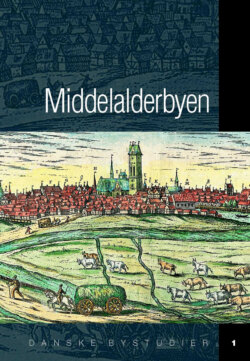Читать книгу Middelalderbyen - Группа авторов - Страница 24
На сайте Литреса книга снята с продажи.
Summary The Medieval Danish Towns – Urbanization and Research Agendas
ОглавлениеBy Søren Bitsch Christensen, PhD, Director, Danish Centre for Urban History
Based on historiographical reading, the article gives an introduction to the Danish urbanization 700-1536 and points to likely and promising future research agendas.
Within the last two or three generations of researchers Danish medieval urban history has achieved important new results in relation to the understanding of the early urbanization and the phases of medieval urbanization in general as well as to the character of the social, economic and cultural aspects of medieval urbanism. At the same time, however, research has been characterized by clearly demarcated institutional and methodological paradigms.
The general urbanization has mainly been understood within a central place logic. In the 1970s and 80s new and pragmatic definitions of towns were accepted, prompted both by methodological thinking primarily by Swedish researchers – and archaeological findings of early settlements from the 7th to the 9th century, which is even before the foundation of the first real town, Ribe in around 710. The proper urbanization is still being dated to the period from the 12th to the 14th century with the largest urban growth occurring in the 13th century. At that time a total of 112 medieval locations could be attributed urban status in the area of the Kingdom of Denmark including the Duchy of Schleswig and Scania.
The article takes the view that the raison d’etre of urbanization around 1200 changed decisively from the Weberian consumer town of a ‘townscape’ defined by the royal needs and power, into the ‘mercantile town’ of a market economic ‘townscape’ of a central place order only supplied by a handful of network towns such as Ribe and later Elsinore, Copenhagen, Flensburg, and Husum.
The history of the material aspects of medieval urbanism is embedded in two different approaches, the empirical and excavation-based Danish tradition and a Swedish and, to some extent, Norwegian approach that is inspired by processual archaeology and new cultural history. The Danish urban archaeologists have produced an outstanding amount of new results, but they are often challenged by their Scandinavian colleagues when it comes to interpretation.
Today’s research into the social consequences of urbanism seems to follow a trend of understanding the past on its own terms. As a part of this, leading Danish medieval historians more often than before look for patterns of how the great social disparities were reflected into group structures such as guilds and town magistrates that were either dividing or uniting urban communities. On the other side, mental structures are now being paid attention as well, first of all the importance of gender and religious ideas and pratices.
Finally, the article gives examples of how the urban space can be explored by means of methods from both archaeologists, cultural, and social historians. All of them are in some ways dealing with concepts like contested space and identitymaking space.
